 Fleet Aircraft Carrier 1944-2017: HMS Elephant (1944), HMS Hermes (1959-85), INS Viraat (1986-2021)
Fleet Aircraft Carrier 1944-2017: HMS Elephant (1944), HMS Hermes (1959-85), INS Viraat (1986-2021)British Cold War Carriers:
Majestic class | Centaur class | HMS Victorious | HMS Eagle | HMS Ark Royal | HMS Hermes | CVA-01 project | Invincible class | HMS Argus | Queen Elisabeth class (planned)The story of HMS Hermes is one of an aircraft carrier with the longest service in hostory so far: HMS Hermes (R12). From keel laying in 1944 to scrapping in 2021, HMS Hermes had been around for 77 years, with more than half a century continuous service… Started as a Centaur class ship, originally part of the 1942 light fleet aircraft carrier program’s Centaur class, she was rebuilt, redesigned, and modernized four time, for a career spanning not only the whole cold war, but also decades afterwards as INS Vikrant. She would be most remembered as the Falkland’s war core for fleet operations. She was also a pioneer for Britain’s or worldwide VTOL operations for that matter. #coldwar #hermes #aircraftcarrier #seaharrier #falklandswar
Part of the Centaur class
It is properly amazing that a ship which such a long career was almost cancelled and scrapped amidst post-war budget restrictions. She was started as part of the very ambitious 1942 light fleet aircraft carrier, which first Colossus class only had four ships in service at the end of WW2 in the British Pacific Fleet. The rest had various fates, most being sold to foreign navies, as did all ships of the improved Majestic class. However in 1944, the third wave of keels was suspended as aviation technology advanced rapidly. If most ships were laid down in 1944 as scheduled for completion with a new design, intermediary to the Illustrious/Implacable classes, construction was suspended in 1945, pending their fate.
Fortunately for the most advanced, the Royal Navy needed a new generation of jet-capable aircraft carriers despite their limited size, and they were completely redesigned for such operations, including notably an angle deck, new landing system, new radars, AA, lifts, catapults, flight deck and hangar.
In the end, HMS Albion, Centaur, Bulwark and Hermes were effectively completed, and four more cancelled. They were completed in the early 1950s on a reltively similar design, however Hermes already diverged in numerous ways, so many publications and modern historians had her separated, notably for her second, quite radical upgrade as VTOL carrier, and her third to be resold to India in 1986, plus another while in later Indian service. For this, as announced in the previous Centaur’s post, she deserves her own dedicated page.
A CV with a record career
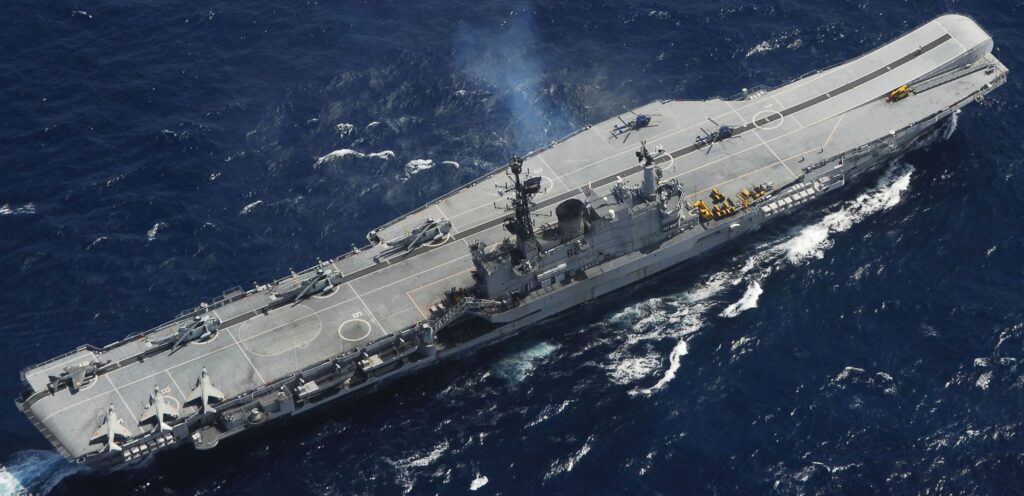
As INS Viraat in the 2000s. When decommissioned in 2017 she really was the oldest aircraft carrier in the world, with a design going back to 1943.
Laid down as HMS Elephant at Vickers-Armstrong on 21 June 1944, she was designed in 1943 as larger version of the Colossus, integrating the same improvements of the Majestics, and going from 13,200 tonnes to 18,300 tonnes and 734 ft (224 m) long instead of 692 ft (211 m). Not an immense difference, but her flight deck and lifts were even firther reinforced to plane for 1945-46 carrier based aircraft then planned, much heavier. This panel included even twin-engine models sure as the late Sea Mosquito and Sea Hornet. However, between shifting priorities and just shortages of labour and resources, construction dragged on until late 1945. After V-Day it was suspended. Discuissions between the RN and government about funding Navy’s needs and save taxpayer’s money had dire consequences. All suspended ships were to be completed for another navy if funded, leaned or sold as is, some were cancelled and BU on slip depending or their advancement, some were completed for the RN in somewhat different roles (two were converted as floating workshops/support carriers and later troop transports), and the rest were pending a complete redesign, to now operate jets.
This was the plan for the larger Centaur class. They appeared better suited than previous classes for jets. But they had to compete for budget with the reconstruction of USS Victorious (very costly) as of HMS Eagle, and Ark Royal. This plan was to provide the RN with three modernized fleet carriers and six, later four lighter fleet carriers. In this plan, HMS Elephant still on the slipway at Barrow-in-Furness (Cumbria) was considered for redesign and completion to a new design in 1950. This was the same standard chosen for all surviving light carriers of the RN, but also some of those sold abroad. This postwar design in reality evolved into three successive more advanced variants, and the four Centaur class were to have the latest.
Eventually funding was obtained and work resumed on her hull left as it was after eight years, in 1952, but onl to clear the slipway, so she could be launched, on 16 February 1953. She was then towed and anchored nearby for a completion that was still not scheduled, and her fate remained in limbo untel 1957, so she would have the very latest upgrades unlike her sisters completed in 1953-55. That benefited her most.
Design(s) of HMS Hermes
This will be relatively succint as the matter has been well covered already on the centaur class page. Unlike her sisters, Hermes was the last ship completed, in 1959 and only one to be fully modernized. Her sisters Albion and Bulwark were completed with interim angled flight decks and hydraulic catapults and later became commander carriers with helicopters, and HMS Centaur partially modernized with steam catapults and stuck with an air group of soon obsolete Havilland Sea Vixen fighters until 1965 when decommissioned, barely six years after Hermes was completed. So she had a state of the art “full package” upgrade as the very last of the WW2 carriers.
Her initial design in 1942 was revised in 1943 and in the early sketches, she was tailored for a post-war career, using hybrid of merchant/warship standards. Hardened steel was used for her flight deck, longtitudinal protective bulkhead and middle deck over the machinery as well as the lower decks over the aviation fuel, plus 2-inch non-cemented armour over sensitive ammunitions and avgas tanks, mild steel elesewhere. This hull was enlarged so to accept larger aircraft and the flight deck extra 1-inch of hardened steel was meant for this also. The initial axial flight deck had a sningle catapult and armament ramped up to four twin 4.5-inch BD guns.
All this was reviewed and revised in 1947 with upgraded peacetime living arrangements and part of the aft hangar converted for extra living space. There was now a reduced 381 ft surface, and a second catapult added while the 4.5 inch guns were removed, the island was redesigned with new radar derrick masts and CiC. The first intended radars were the Type 980 and gunnery air search Type 293, plus two Type 277Q, but this was all cancelled for HMS Hermes as she underwent a third, 1950s redesign.
Final design: Hull, Island
As her final design was ironed out in 1955, she measured 198.12 m (650 ft) long between parallels, 225.20 m (738 ft 10 in) overall (versus 224.8m oa on her sisters) for 27.43 m (90 ft) in beam at waterline level and 43.90 m (144 ft) at flight deck level, with a the latest version of the angled configuration. This was the most spacious of all light fleet carriers. This was paid also by the largest displacement at 23,900 long tons (24,300 t) standard and 28,700 long tons (29,200 t full load. Draught was 8.50 m (27 ft 11 in) standard and 8.80 mean, when fully loaded.
Her protection was unchanged from her sister ships, her inner belt was 25mm thick, her flight deck 19mm, the box protection of magazines was 51mm and machinery glacis 25mm, all in hardered steel or cemented armour.
Powerplant
No change compared to her sisters: It consisted in two shaft geared Parsons steam turbines coupled with four Admiralty 3-drum boilers, a classic configuration at 76,000 shp, with a top speed of 28.5 knots (52.8 km/h, 32.8 mph) and a Range of 6,000 nautical miles (11,000 km; 6,900 mi) at 20 knots thanks to 4200t of oil (more than her sisters). There were overhauled during her career but not a serious replacement of any of the turbines or boilers, making it the more impressive she ran with this until decommission.
Armament
The initial 6 barrel Mark VI 40mm Bofors which became widepsread on postwar RN ships. They were installed also on HMS Hermes. She was in 1950 to be completed with a somewhat outdated armament, inerited from WW2 and just brought to new standard with better fire control: Thirty-two 40 mm Bofors guns in all, placed in two of the nw six-tubes British mounts, and eight twin, more standard mounts, rounded by four single Bofors. In the end this was reduced to just ten 40 mm Bofors in five twin 40mm/60 Mk 5 mounts.
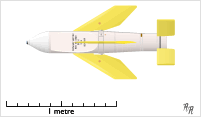 After 1970 she received two Sea Cat launchers, replacing the former 6-tubes Bofors mounts. Seacat were 1960 short-range SAM designed to replace the ubiquitous Bofors, and world’s first operational shipboard point-defence missile system, replacing Bofors monunts as a one-per-one basis, and using existing fire-control systems. In 1982 it ws unsure if this was the GWS.22 (SACLOS guidance) of the very last GWS.24 (fully automatic engagement).
After 1970 she received two Sea Cat launchers, replacing the former 6-tubes Bofors mounts. Seacat were 1960 short-range SAM designed to replace the ubiquitous Bofors, and world’s first operational shipboard point-defence missile system, replacing Bofors monunts as a one-per-one basis, and using existing fire-control systems. In 1982 it ws unsure if this was the GWS.22 (SACLOS guidance) of the very last GWS.24 (fully automatic engagement).
Main specs:
68 kg (150 lb) for 1.48 x 0.22 x 0.70 m (58 in x 8.7 in x 28 in), Warhead 40 lb (18 kg) continuous-rod, Proximity fuse
2 stage motor, range 500–5,000 m at Mach 0.8 Guidance SACLOS, radio link, full auto.
Sensors
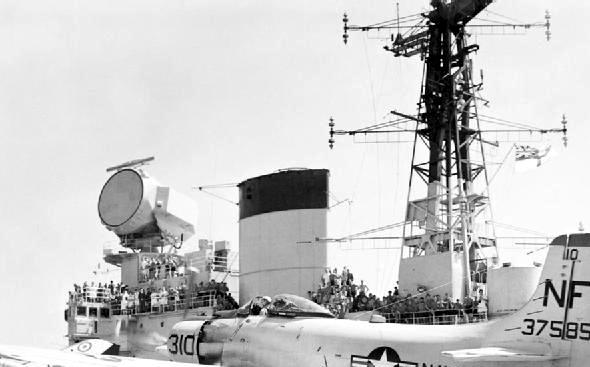
The famous pot-shaped Type 284 radar, also present on HMS Victorious and Eagle.
Type 984: A 3D S band system used for both controlled interception (GCI) and secondary early warning system, range 180 nmi (330 km; 210 mi).
Type 982: Air Search/Surface S-band Search 500kW radar, with 2.2/19 hor/vert bwt, vwl 0.1m, 2.997GHz, range 161 km src
Type 262: Beamwidth 5.2, 30kW turret-mounted Director FCR, Conical Scan for AA Fire Control src
Type 974 radars: An X-band radar for maritime reconnaissance and navigation, modified version of the Decca Type 12 civilian radar. It had an AKL type antenna with separate transmitting/receiving antennas, turntable with motor drive, and modulator, transmitter and HF modules.
Early Air Group (1960)
On HMS Hermes, this was revised considerably. Not only the flight deck was englarged and the angle deck more pronounced at 6.5°, but if the Hangar height was the same, she now had two lifts, with a fore deck edge lift measuring 16.5 x 10.7m (54 x 35 ft) supporting 15.9t aircraft, and an aft centerline lift same size as before at 16.5 x 13.4m and supporting 15.9t. She was also fitted from the start with two B5-4 catapults from the start. They were placed side to side forward, but too close to launch jets simultaneously. They were eliminated in 1981 and a ski jump ramp built instead (see later).
The early group probably comprised a mix of Scimitar F.1, and Sea Vixen FAW.1, four Gannet AEW.3 turboprop engine models and six Whirlwind HAS.7 helicopter for SAR, patrol and liaison.
In 1966 HMS Hermes ran a park of 12 Sea Vixen FAW.2, 7 Buccaneer S.1, and still the four Gannet AEW.3 but also a single Gannet COD.4 and five Wessex HAS.3 helicopters for a total of 29. It will change again in 1977 and 1982.
Hermes as completed (1959)

Blackburn Bucaneer S2, serial TXT275, 801 Naval Squadron, HMS Hermes 1970
In 1959 she was planned to carry Sea Hawk, Sea Vixen, Scimitar fighters, Gannet ASW planes, Sea Venom, Gannet ECM planes, Skyraider, Gannet EW planes, and a single Dragonfly helicopters.
In 1966 she carried 12 Sea Vixen FAW.2, 7 Buccaneer S.1, 4 Gannet AEW.3, one Gannet COD.4 and 5 Wessex HAS.3 helicopter, so a comfortable park of 28 aircraft.
801 NAS: 7 Blackburn Buccaneer S.2
893 NAS: 12 de Havilland Sea Vixen FAW.2
849A NAS: 4 Fairey Gannet AEW.3, 1 Fairey Gannet COD.4
814 NAS: 5 Westland Wessex HAS.3 (ASW)
Ships Flight: 1 Westland Wessex HAS.1 (SAR)
It was proposed at Parliament in 1964 to have her operating F4 Phantoms, long discussions and positive tests, notably with the modified RN F-4K versions tailored for the smaller british carriers. But this was cancelled as this would have too many limitations in operations, and cost.
Hermes as amphibious assault carrier (1971)

As commando carrier, date unknow, src unknown via pinterest
In 1971, Hermes started her first major refit since 1959: She was converted as an amphibious assault carrier, able to carry a total of nine Sea King HAS.1 and four Wessex HU.5 to quickly brought Royal Marines at any point inland from international waters.
This really was mission-oriented. She was modified and refitted to carry and operate Wessex helicopers, but numbers and complement (other SAR or plane guard models) changed. It was planned at first up to 18 Wessex or more but her troop carrier receded for a more NATO firendly ASW carrier. The height of the Wessex (15 ft 10 in (4.83 m)) barely fit inside the 5.3m (17-1/4 feet) hangar, with two feet to spare. It is not even sure she ever served long in that configuration.
In 1977 she carried nine Sea King HAS.1, four Wessex HU.5 helicopters. Again, the larger size of the Sea King was an issue for the hangar. At 16 ft 10 in (5.13 m) she “scratched the roof” with a feet to spare. Eventually when acting as pure ASW carrier in the North Atlantic, she was fit to operate 20 Westland Sea King helicopters.
⚙ Hermes 1977 pecifications |
|
| Displacement | 23,900 tons standard, 28,700 tons FL |
| Dimensions | 198.1 pp 226.9 oa x 27.4 wl 44.1 oa (48.8 oa since 1966) x 8.80 mean draft |
| Propulsion | Same as Centaur |
| Speed | Same as Centaur |
| Range | Oil 4200t, 10,000 nm/20 kts |
| Armament | 5×2 40mm/60 Bofors Mk 5, see notes |
| Sensors | Type 984, type 982, 5x type 262, type 974 radars |
| Crew | 2100, see notes |
Reconstruction of HMS Hermes (1980)

With her sky jump she could be updated with the brand new sea harrier in 1980-81, carrying sixteen Sea Harrier FRS.1 multirole, and eighteen Sea King HAS.5 so 34 aircraft in all. Of course part of the park was permanently on deck. The Sea Harrier was 12 ft 2 in (3.71 m) tall and also barely fit inside the hangar.

Hawker Sea Harrier FRS Mk.1, 899 NAS Flaklands 1982
Her first recommissioned air group was:
800 NAS: 5 Sea Harrier FRS.1 fighter
826 NAS: 12 Sea King HAS.5 ASW
With the Falklands war however, she was put into “wartime complement” and her last air group was expanded as following:
800 NAS: 15 (10+) Sea Harrier FRS.1
826 NAS: 5 Sea King HAS.5
846 NAS: 5 Sea King HC.4
No. 1 Squadron RAF: 6 Harrier GR.3
So she carried both Navy and RAF Harriers, putting to good use her ski ramp, ad park of 21 Harriers all armed with sidewinder missiles proved enough deterrent to ensure the protection of the fleet (to some extent) and covering land operations as well.
⚙ Hermes 1982 pecifications |
|
| Displacement | 23,900 tons standard, 28,700 tons FL |
| Dimensions | 198.1 pp 226.9 oa x 27.4 wl 44.1 oa (48.8 oa since 1966) x 8.80 mean draft |
| Propulsion | Same as Centaur |
| Speed | Same as Centaur |
| Range | Oil 4200t, 10,000 nm/20 kts |
| Armament | 5×2 40mm/60 Bofors Mk 5, see notes |
| Sensors | Type 984, type 982, 5x type 262, type 974 radars |
| Crew | 2100, see notes |
A long career
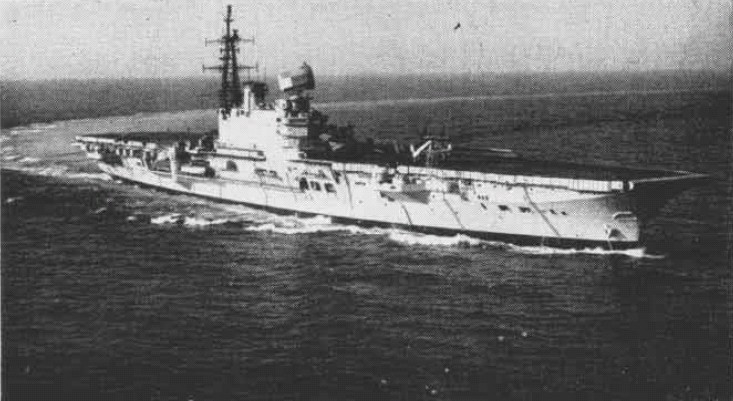
HMS Hermes in 1982
After a long purgatory, staying on slip until work resumed in 1952 and after the ravages of inclement weather, HMS Hermes (pennant R12), renamed from the cancelled Elephant, was Launched merely to clear the slip at Vickers-Armstrong on 16 February 1953. What followed in 1957 was a reconstruction, the most complete of any Centaur, or any 1942 fleet program carriers. She was eventually Commissioned on 25 November 1959, the last of all of these light carrier. At that stage, jets were of the 2nd gen., they went to much higher speed, size and range, and so her air park was also the most advanced. With her new Type 984 “searchlight” 3D radar, fully angled deck, deck-edge lift, new steam catapults she looked like a smaller version of the rebuilt HMS Victorious. It was done at a cost of £18 million, plus £1 million for electronics, £10 million for her 1959 air park of Scimitar, Sea Vixen, Gannet and Whirlwind.
As HMS Hermes
Her fitting out, sea trials, shakedown cruise around the British isles, fixes, weapons testings and aircraft qualifications went on between 1960 and 1961. On 16 November 1962, she was cruising off of the Pembrokeshire coast of Wales when lossing one helicopter carrying to two Members of Parliament, Lord Windlesham and the MP for Loughborough, John Cronin, crashing in the fog while en route to RNAS Brawdy, off St David’s Head. Cronin and the crew survived however and were rescued later.
1963 was uneventful (no logs).
The Phantom controversy
On 2 March 1964 convervative politician John Hay seated as Civil Lord of the Admiralty, declared Parliament on 2 March 1964 that her believed that F4-Phantoms could and will be operated from HMS Hermes and Eagle as well as the CV01 class projected. It was optimistic, as many believed only Victorious could operate the heavily modified RN F-4K version realistically. The later had British Rolls-Royce Spey engines, notably because of the cancellation of the Hawker Siddeley P.1154 V/STOL project. It had a better fuel efficiency and the aicraft had a max takeoff weight of 25 tons compared to the original version of 28 tons on HMS Eagle. It was envisioned that on Hermes, the smallest of these, they would by carrying less fuel for a shorter CAP or airborne refuelling and limited payload. It was believed Hermes they could replace Vixens on a 1-per-1 basis with 11–12 completed by 7–8 Buccaneer. But modifications were not entirely successful and Hermes’s flight deck was clearly too short, she had a weak arresting gear, not powerful enough catapults to recover or launch them. Trias in 1969–1970 proved this. Opposition also argued that in the US, McNamara declared that the F-4 was unsafe to operate of a much larger USN Essex class and John Hay eventually cancelled the program while CVA02 was pushed forward.
The late 1960s and what to do with the carrier
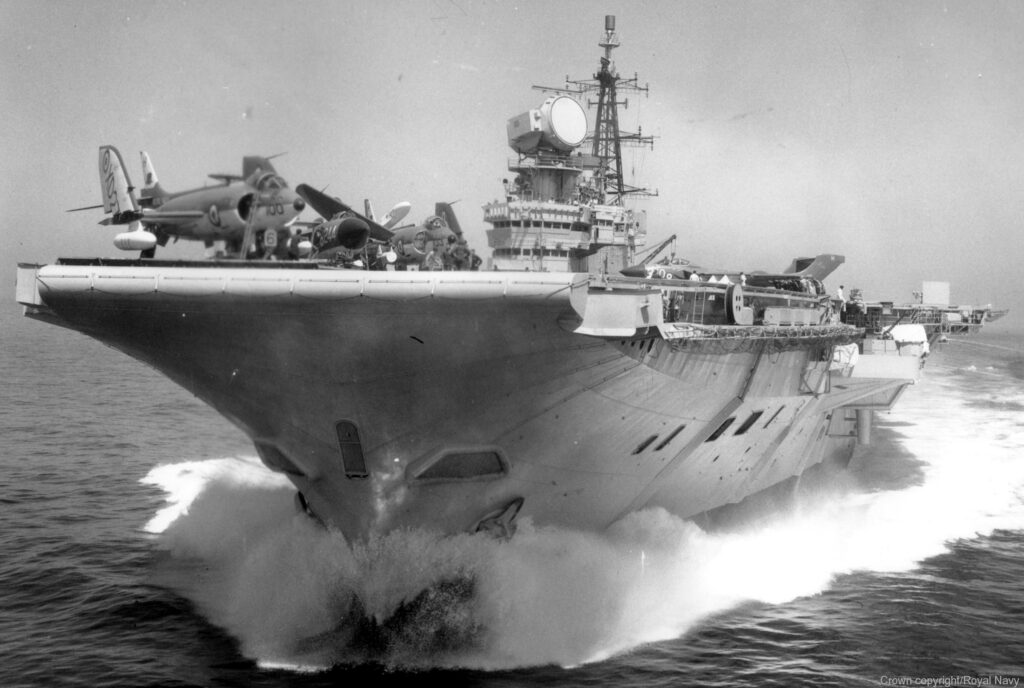
HMS Hermes’s prow underway, late 1960s src
It 1965 it was clear that the carrie’s air park would be obsolete. The Sea Vixen was a 1st gen interceptor, and completely outclassed by everything that flew at the time, notably the soviet MIG-21. No missiles would compensate for that as radar and overall performances were lacking. Too small to operate the very capable F-4, the future was not bright. And so the government started forays to cut costs and found ways to sell or lease her off. In 1966 a review called her “surplus to operational requirements” and suggested a transfer to Australia, which carriers were now obsolete. Both were used in Vietnam for auxiliary roles, like troop transports. They operated notably the A4 Skyhawk, a good fit. She was offered to the RAN as replacement for HMAS Melbourne but without success. Austrlia at that stage tried also to rehape the fleet and cut costs.
In 1968, Hermes took part in a combined exercise with the RAN, to push the case again, being visited by senior RAN officers and government officials, and this included demonstrations of landings of and rtouch-and-go from A-4G Skyhawks, S-2 Trackers, but again, the offer was turned down based on a new white paper review, cost and manpower issues.
Hermes continued to operate as one of the four Royal Navy strike carriers, based on the Indian Ocean for the remaining 1960s, and then the Mediterranean Sea. She was decommissioned in 1970 after not being deployed in May 1967. The US contemplated forming an international fleet to enforce the straits open with force, but the UK backed down.
The Commando Carrier
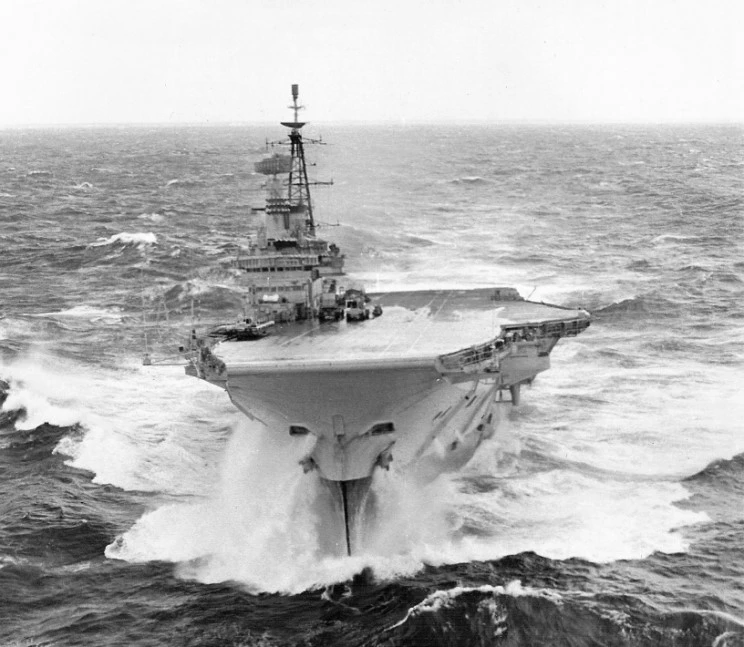
HMS Hermes in the south Atlantic’s winter weather, 1977 src
Still, the navy had hope to keep the carrier operational, especially after a ten years service life which barely justify for the costs of her reconstruction.
Aleady in 1966 it was decided to discard at a later date her fixed wing group. Some proposed to reconvert Hermes as a Commando Carrier for Royal Marine operations, an helicopter carrier equivalent to the USN LHA. R12 thus, entered after decommission, 10 Dock, Devonport Dockyard and between 1971 and 1973 underwent a conversion: Arresting cables, steam catapults, 3-D radar were removed, Landing craft davits installed, provision for more as well as berthing for 800 troops incorporated inside the hangar, whereas she had a new smaller helicopter airwing composed of 20 Westland Sea King helicopters. She operated that way in 1973-76, but never made an overseas active deployment in her quality, only performing routine training and amphibious operations.
In 1976, the Soviet submarine threat came to such as dedree, NATO pressured the RN to answer the call, with HMS Hermes, which only needed cosmetic changes. Thus commenced her third conversion, as an anti-submarine warfare carrier slated to patrol the most critical parts of the North Atlantic, including the GUIK gap, gateway of Soviet SSNs. She operated that way after several months of work and a new air park of ASW specialized Sea Kings. She operated that way from 1973 to 1980. At that stage it was believed he could be decommissioned, but there were not that many carriers around left and the CV02 program has been cancelled. A new class was in construction, which were specialized STOVL carriers. She would become a prototype.
The VTOL Carrier
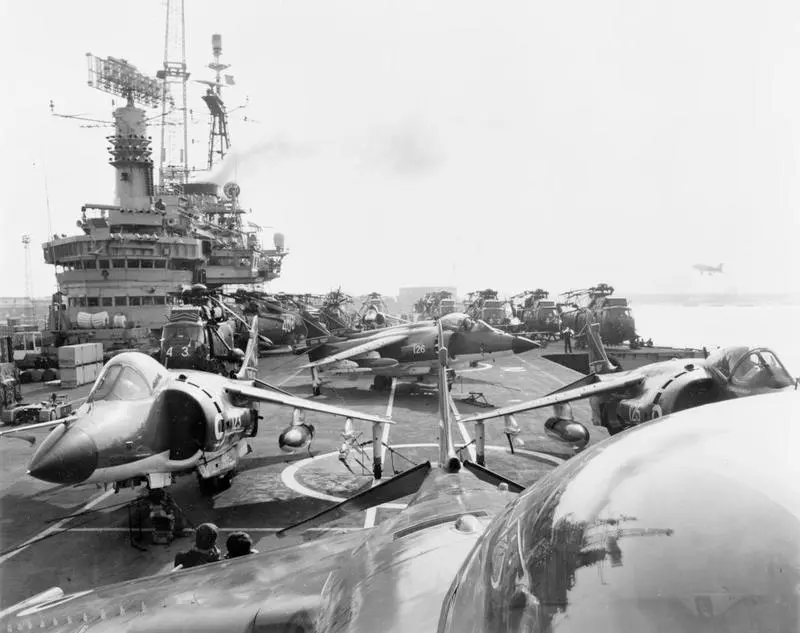
View looking aft down HMS HERMES’ flight deck as she sails from Portsmouth for the South Atlantic. Five Sea Harriers of No 800 Squadron Fleet Air Arm are visible on the crowded flight deck in front of a mass of Sea Kings. At the time of sailing, the crew had not had time to organize the stowing of aircraft or supplies. IWM (FKD 674) src
Hermes underwent one more conversion as the Harrier program, after cancellation, was revived to take advantage of these old and fure smaller carriers. New capabilities were added as refitted at Portsmouth from 1980 to June 1981 (see above), featuring notably a brand new 12° ski-jump plus facilities to operate the BAe Sea Harrier. She was due to be decommissioned in 1982 following the 1981 Defence Review as a cheap alternative to a new carrier. As the Falklands War broke out, barely out of yard and performing aircraft qualifications, she became flagship of the British forces and was ordered to sail to the South Atlantic three days after the Argentine invasion.
She sailed with an airgroup of 12 Sea Harrier FRS1 attack aircraft of the Fleet Air Arm, plus multirole 18 Sea King helicopters. More aircraft were flown aboard or transported by ships to losses, augment the task force in operation when she arrived. Her final combat air group went to 16 Sea Harriers (800 NAS), plus ten Hawker Siddeley Harrier GR3s of the RAF (No. 1 Squadron RAF, later reduced to 6) as well as 10 Sea Kings (826 NAS: 5 Sea King HAS.5, 846 NAS: 5 Sea King HC) then less when some were dispersed to other ships.
She also carried a Special Air Service (SAS) unit and Royal Marines. As Britain’s largest carrier in service, she was considered too valuable to close in to the Falklands, fearing Argentine attacks, and Harriers were obliged to operate at the limit of their endurance radius. A CAP was permament and did its job as repelling any attacks. The Skyhawks lacked the range, but Dassault Super Etendards with their exocet missiles definitely did. She was never on danger. Argentine’s own carrier, 21 de Mayo, also never saild out for an attack, fearing British submarines after the loss of General Belgrano. Long story short, HMS Hermes performed and well proved instrumental in retaking the islands.
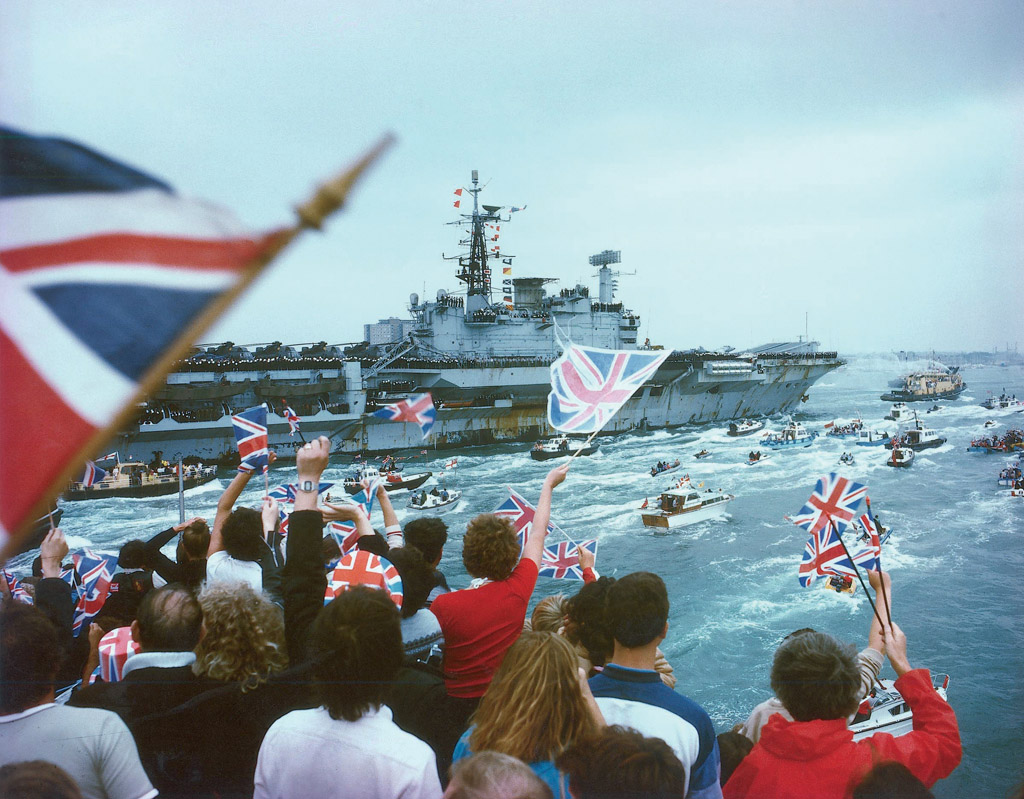
Famous photo, return from the Falklands, the hero’s welcome (src).
After her hero’s welcome return from the Falklands she entered a 4-month refit affecting her propulsion (for the first time since 1960 !) and complete rework of her electrical systems, cleaning and repainting as southern hemisphere icy waters were not tender to her old hull. This was completed in November 1982 and performed work-ups exercises and her second proper shakedown. She took her place in the 1982 NATO organization and multiplied exercises in the North Atlantic, but later also in the Mediterranean Sea as commando carrier. In the autumn of 1983 she took part in exercize Ocean Safari, as strike carrier with 12 Sea Harriers, 10 RAF Harrier GR.3s, 10 Sea Kings. Back home for a refit in Devonport as with new carriers now commissioned, she was placed in maintained reserve in Portsmouth (meaning she could be revived at any moment with minimal warning).
In 1983, as new the carrier HMS Invincible was proposed to the RAN, then cancelled after the Falklands War, she was scheduled to replaced Hermes, which was agains proposed with a squadron of Sea Harriers to Australia. Again, the new Hawke government which was to decided about the replacement of HMAS Melbourne, declined the offer.
R12 was kept nevertheless in service until 12 April 1984. She entered Portsmouth with a reduced crew flying the White Ensign signalling her close decommission.
The old carriershould have been stricken and BU by now, but there was a last twist of fate, as if Neptune itself, concerned about the old hull he knew so well, bended some magical cords with an unexpected offer:
As INS Viraat (1986-2017)
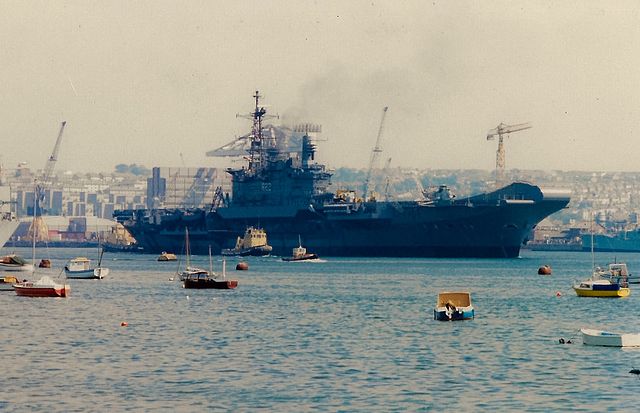
HMS Hermes sailing from Devonport as Viraat, 1987
Indeed, at that stage in 1985, India approached the British government about a possible sell, to replace INS Vikrant transferred in 1961 and now completely outdated. After ongoing negociation to transfer her with a new air park and modernization, an agreement was concluded and in April 1986, Hermes was towed from Portsmouth reserve to Devonport Dockyard for her ultimate refitting and reactivated, recommissioning in Britain as INS Viraat. In 1987 she left Devonport for her long voyage to India.
Her new life with the Indian Navy would bring her for another long round of useful service, from 12 May 1987 until her secommissioned on 6 March 2017, so a well rounded thirty years !
During all this time (a dedicated post on Viraat will be made in the future), she became flagship of the Indian Navy until INS Vikramaditya was commissioned in 2013. But she only ceased operations on 23 July 2016. She was a multirole aircraft capable of amphibious operations as well as trikes, with magazine containing at least 80 lightweight torpedoes for AS/ASW operations as well, she el retained commando transport capability with accomodation for 750 troops four LCVP landing craft aft, an air group of 26 combat aircraft and helicopters.
Her air group comprised the following:
INAS 300 “White Tigers sqn” (BAE Sea Harrier)
INAS 552 “The Braves sqn” (BAE Sea Harrier)
INAS 321 “Angels sqn” (Alouette III/HAL Chetak SAR helicopters)
INAS 330 “Harpoons sqn” (ASW Westland Sea King)
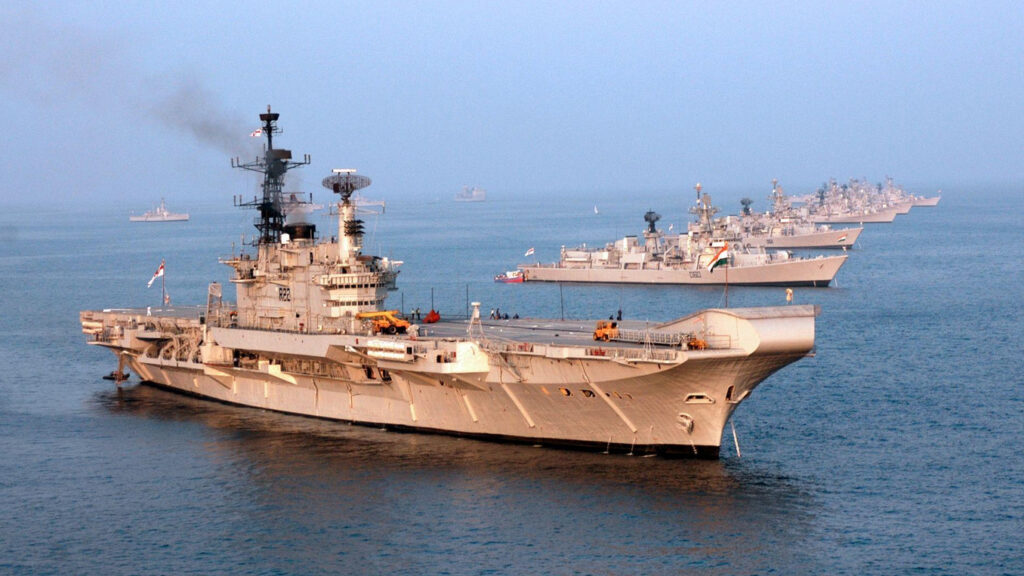
INS Viraat final days, in full regalia with her escort, 2017. src
By 2006 her air group underwent a ‘Limited Upgrade Sea Harrier (LUSH)’ program with Israeli systems. Her Chetak were replaced also by Kamov Ka-31 Helix-B airborne early warning aircraft and Kamov Ka-28 Helix-A helicopters. Sea Harrier operations ceased on 6 May 2016.
Following her decommissioning in 2017, there was a bi-national crowdfunding campaign to preserve her as floating museum, which was unable to raise the slated £100,000 (falling short of £9,303), and this was cancelled. On 1 November 2018 the Maharashtra cabinet approved however her conversion as a moored maritime museum and marine adventure centre near Nivati, Sindhudurg, but no financially backed, this was cancelled as well ans scrapping decided on 1 July 2019 by the MoD in Alang, but this was placed on hold after 5% scrapping for a petition by a private firm, later dismissed as 40% scrapping was done. As of 2023 it is complete. It is likely her bell was preserved at the Indian Naval Academy at Ezhimala, an international naval tradition.
Read More/Src
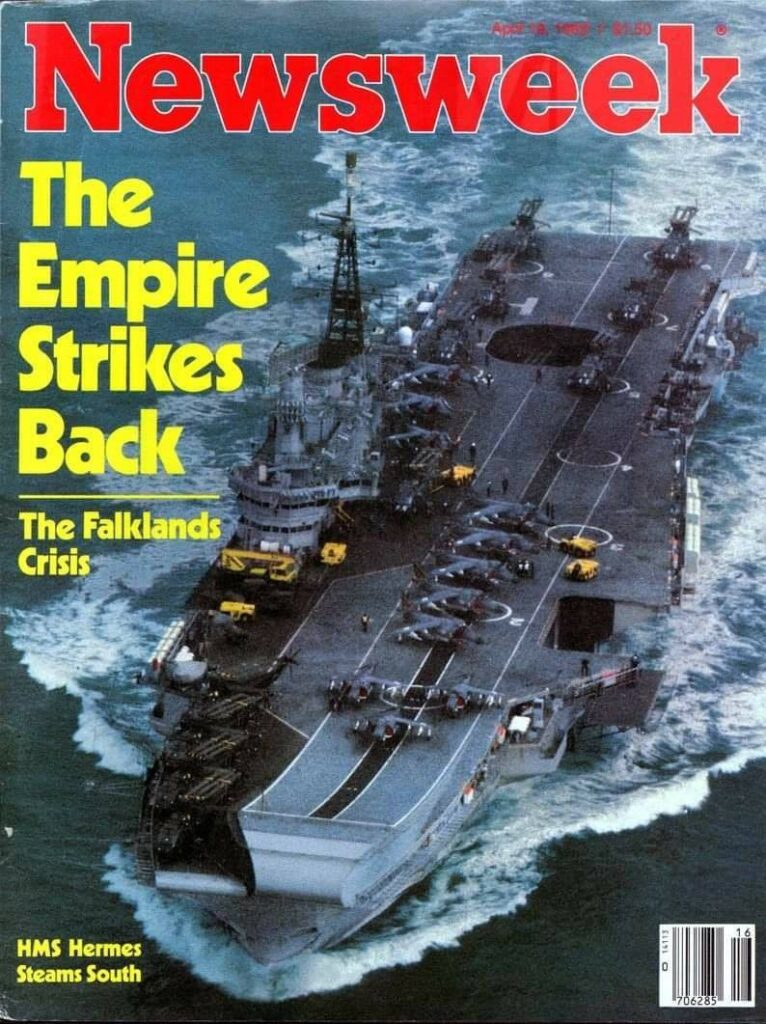
Famous Nesweek Cover “The empire’s strikes back” also reference to the just came out Stawrwars movie (and personal favorite of the whole franchise)). src
Books
Links

https://www.navypedia.org/ships/uk/brit_cv1_centaur.htm
https://en.wikipedia.org/wiki/HMS_Hermes_(R12)
https://www.armedconflicts.com/CV-HMS-Hermes-R12-t30576
https://peek-01.livejournal.com/14495.html
https://laststandonzombieisland.com/tag/hermes/
https://www.worldnavalships.com/forums/thread.php?threadid=114&page=5
https://www.royalnavy.mod.uk/-/media/royal-navy-responsive/images/navynews/archivepdfs/1980s/1982/navy-news-august-1982-issue-337.pdf
https://www.quora.com/What-happened-to-the-HMS-Hermes-aircraft-carrier
https://www.seaforces.org/marint/Royal-Navy/Aircraft-Carrier/R-12-HMS-Hermes.htm
https://en.wikipedia.org/wiki/INS_Viraat
https://ukdefenceforum.net/viewtopic.php?t=154
https://www.helis.com/database/unit/618-HMS-Hermes
https://alchetron.com/HMS-Hermes-%28R12%29
https://commons.wikimedia.org/wiki/Category:HMS_Hermes_(R12)
Videos
Early service footage 1960
Service footage Falklands
Return home, 1982
INS Viraat official decommission ceremony, 2017
Model Kits
https://www.scalemates.com/kits/orange-hobby-n07-006-480-hms-hermes-r12–177193

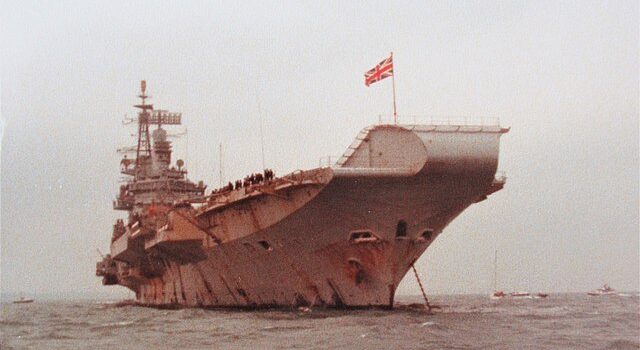
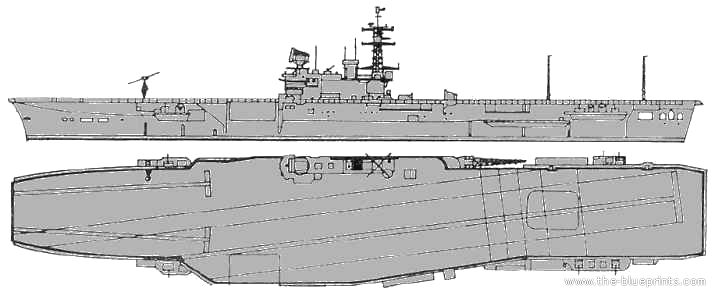

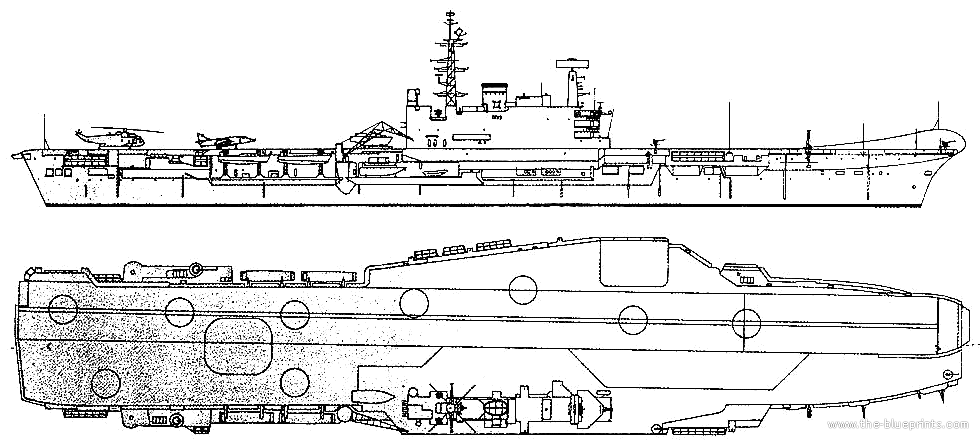
 Latest Facebook Entry -
Latest Facebook Entry -  X(Tweeter) Naval Encyclopedia's deck archive
X(Tweeter) Naval Encyclopedia's deck archive Instagram (@navalencyc)
Instagram (@navalencyc)





 Austrian Navy
Austrian Navy French Navy
French Navy Royal Navy
Royal Navy Armada Espanola
Armada Espanola K.u.K. Kriegsmarine
K.u.K. Kriegsmarine Dansk Marine
Dansk Marine Nautiko Hellenon
Nautiko Hellenon Koninklije Marine 1870
Koninklije Marine 1870 Marinha do Brasil
Marinha do Brasil Osmanlı Donanması
Osmanlı Donanması Marina Do Peru
Marina Do Peru Marinha do Portugal
Marinha do Portugal Regia Marina 1870
Regia Marina 1870 Nihhon Kaigun 1870
Nihhon Kaigun 1870 Preußische Marine 1870
Preußische Marine 1870 Russkiy Flot 1870
Russkiy Flot 1870 Svenska marinen
Svenska marinen Søværnet
Søværnet Union Navy
Union Navy Confederate Navy
Confederate Navy Armada de Argentina
Armada de Argentina Imperial Chinese Navy
Imperial Chinese Navy Marinha do Portugal
Marinha do Portugal Mexico
Mexico Kaiserliche Marine
Kaiserliche Marine 1898 US Navy
1898 US Navy Russkiy Flot
Russkiy Flot French Naval Aviation
French Naval Aviation Russian Naval Aviation
Russian Naval Aviation Sovietskiy Flot
Sovietskiy Flot Royal Canadian Navy
Royal Canadian Navy Royal Australian Navy
Royal Australian Navy RNZN Fleet
RNZN Fleet Chinese Navy 1937
Chinese Navy 1937 Kriegsmarine
Kriegsmarine Chilean Navy
Chilean Navy Danish Navy
Danish Navy Finnish Navy
Finnish Navy Hellenic Navy
Hellenic Navy Polish Navy
Polish Navy Romanian Navy
Romanian Navy Turkish Navy
Turkish Navy Royal Yugoslav Navy
Royal Yugoslav Navy Royal Thai Navy
Royal Thai Navy Minor Navies
Minor Navies Albania
Albania Austria
Austria Belgium
Belgium Columbia
Columbia Costa Rica
Costa Rica Cuba
Cuba Czechoslovakia
Czechoslovakia Dominican Republic
Dominican Republic Haiti
Haiti Hungary
Hungary Honduras
Honduras Estonia
Estonia Iceland
Iceland Eire
Eire Equador
Equador Iran
Iran Iraq
Iraq Latvia
Latvia Liberia
Liberia Lithuania
Lithuania Mandchukuo
Mandchukuo Morocco
Morocco Nicaragua
Nicaragua Persia
Persia San Salvador
San Salvador Sarawak
Sarawak Uruguay
Uruguay Venezuela
Venezuela Zanzibar
Zanzibar Warsaw Pact Navies
Warsaw Pact Navies Bulgaria
Bulgaria Hungary
Hungary

 Bundesmarine
Bundesmarine Dutch Navy
Dutch Navy Hellenic Navy
Hellenic Navy Marina Militare
Marina Militare Taiwanese Navy
Taiwanese Navy Chinese Navy
Chinese Navy Indian Navy
Indian Navy Indonesian Navy
Indonesian Navy JMSDF
JMSDF North Korean Navy
North Korean Navy Philippines Navy
Philippines Navy ROKN
ROKN IDF Navy
IDF Navy Royal New Zealand Navy
Royal New Zealand Navy Egyptian Navy
Egyptian Navy South African Navy
South African Navy

































 RN
RN
 Marine Nationale
Marine Nationale
 Soviet Navy
Soviet Navy
 dbodesign
dbodesign